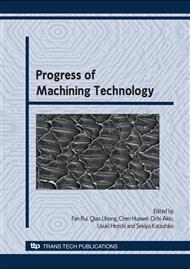[1]
Vickers G W. Ball-mills versus end-mills for curved surface machining[J]. J. Engineering for Industry. 1989, 22(111): 22-26.
DOI: 10.1115/1.3188728
Google Scholar
[2]
Warkentin A, Bedi S, Ismail F. Five-axis milling of spherical surfaces[J]. International Journal of Machine Tools and Manufacture. 1996, 36(2): 229-243.
DOI: 10.1016/0890-6955(95)98763-w
Google Scholar
[3]
Rao N, Ismail F, Bedi S. Tool path planning for five-axis machining using the principal axis method[J]. International Journal of Machine Tools and Manufacture. 1997, 37(7): 1025-1040.
DOI: 10.1016/s0890-6955(96)00046-6
Google Scholar
[4]
Warkentin A, Ismail F, Bedi S. Comparison between multi-point and other 5-axis tool positioning strategies[J]. International Journal of Machine Tools and Manufacture. 2000, 40(2): 185-208.
DOI: 10.1016/s0890-6955(99)00058-9
Google Scholar
[5]
Warkentin A, Ismail F, Bedi S. Multi-point tool positioning strategy for 5-axis mashining of sculptured surfaces[J]. Computer Aided Geometric Design. 2000, 17(1): 83-100. a. Tool path computational result b. Simulation result Fig 6 Tool path generation of a b-surface.
DOI: 10.1016/s0167-8396(99)00040-0
Google Scholar
[6]
Gray P, Bedi S, Ismail F. Rolling ball method for 5-axis surface machining[J]. Computer-Aided Design. 2003, 35(4): 347-357.
DOI: 10.1016/s0010-4485(02)00056-8
Google Scholar
[7]
Gray P J, Ismail F, Bedi S. Graphics-assisted Rolling Ball Method for 5-axis surface machining[J]. Computer-Aided Design. 2004, 36(7): 653-663.
DOI: 10.1016/s0010-4485(03)00141-6
Google Scholar
[8]
Li Z, Chen W. The analysis of correlative error in principal axis method for five-axis machining of sculptured surfaces[J]. International Journal of Machine Tools and Manufacture. 2005, 45(9): 1031-1036.
DOI: 10.1016/j.ijmachtools.2004.11.025
Google Scholar
[9]
Gray P J, Bedi S, Ismail F. Arc-intersect method for 5-axis tool positioning[J]. Computer-Aided Design. 2005, 37(7): 663-674.
DOI: 10.1016/j.cad.2004.08.006
Google Scholar
[10]
Sheltami K, Bedi S, Ismail F. Swept volumes of toroidal cutters using generating curves[J]. International Journal of Machine Tools and Manufacture. 1998, 38(7): 855-870.
DOI: 10.1016/s0890-6955(97)00053-9
Google Scholar
[11]
Lee J J, Suh S H. Interference-free tool-path planning for flank milling of twisted ruled surfaces[J]. The International Journal of Advanced Manufacturing Technology. 1998, 14(11): 795-805.
DOI: 10.1007/bf01350764
Google Scholar
[12]
T H K, Gey C, Rackow N. Flank milling optimization - the flamingo project[J]. Air & Space Europe. 2001, 3(3-4): 60-63.
DOI: 10.1016/s1290-0958(01)90058-9
Google Scholar
[13]
Bedi S, Mann S, Menzel C. Flank milling with flat end milling cutters[J]. Computer-Aided Design. 2003, 35(3): 293-300.
DOI: 10.1016/s0010-4485(01)00213-5
Google Scholar
[14]
Lartigue C, Duc E, Affouard A. Tool path deformation in 5-axis flank milling using envelope surface[J]. Computer-Aided Design. 2003, 35(4): 375-382.
DOI: 10.1016/s0010-4485(02)00058-1
Google Scholar
[15]
Menzel C, Bedi S, Mann S. Triple tangent flank milling of ruled surfaces[J]. Computer-Aided Design. 2004, 36(3): 289-296.
DOI: 10.1016/s0010-4485(03)00118-0
Google Scholar
[16]
Chih-hsing C, Jang-ting C. Five-axis flank machining of ruled surfaces with developable surface approximation[C]. (2005).
DOI: 10.1109/cad-cg.2005.41
Google Scholar
[17]
Wu P H, Li Y W, Chu C H. Optimized tool path generation based on dynamic programming for five-axis flank milling of rule surface[J]. International Journal of Machine Tools and Manufacture. 2008, 48(11): 1224-1233.
DOI: 10.1016/j.ijmachtools.2008.03.009
Google Scholar
[18]
Chih-hsing C J. Tool path planning for five-axis flank milling with developable surface approximation[J]. Int J Adv Manuf Technol. 2006, 29: 707-713.
DOI: 10.1007/s00170-005-2564-6
Google Scholar
[19]
Liu X W. Five-axis NC cylindrical milling of sculptured surfaces[J]. Computer-Aided Design. 1995, 27(12): 887-894.
DOI: 10.1016/0010-4485(95)00005-4
Google Scholar
[20]
Mann S, Bedi S. Generalization of the imprint method to general surfaces of revolution for NC machining[J]. Computer-Aided Design. 2002, 34(5): 373-378.
DOI: 10.1016/s0010-4485(01)00103-8
Google Scholar


